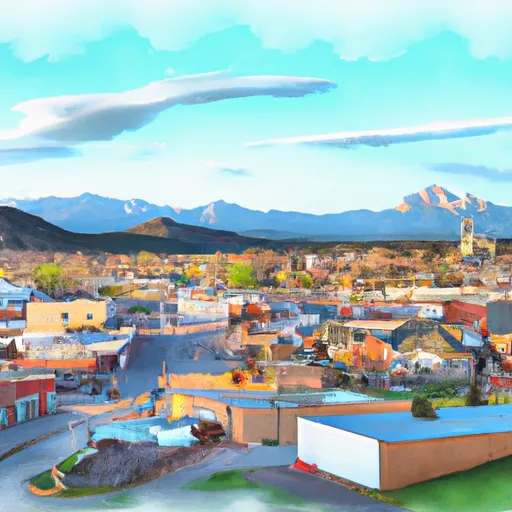-
 Snoflo Premium
Snoflo Premium
Get unlimited access to all our content
With no Ad interruptions! - Start Your Free Trial Login with existing account
Monte-Vista
Eden Index
Climate
6.4
•
Recreation
6.6
•
Community
2.5
•
Safeguard
5.5/10

Monte Vista is a charming town located in Rio Grande County, Colorado. It experiences a semi-arid climate with mild summers and cold, snowy winters. Summers see average temperatures ranging from 70°F to 90°F, while winters drop to 20°F to 40°F. The town receives around 11 inches of precipitation annually, with the majority falling as snow in the winter months.
Monte Vista is blessed with its close proximity to the Rio Grande River, making it an ideal location for outdoor enthusiasts. The river not only provides scenic beauty but also offers opportunities for fishing and boating. Additionally, there are several nearby lakes and reservoirs, including the Monte Vista National Wildlife Refuge, which is home to a diverse range of wildlife and provides excellent bird watching opportunities. Hiking and camping are popular activities in the surrounding San Juan and Sangre de Cristo Mountains. The area also boasts stunning landscapes, including the Great Sand Dunes National Park and Preserve, where visitors can hike, sandboard, and witness the tallest sand dunes in North America. Monte Vista truly offers a haven for nature lovers and outdoor adventurers.
What is the Eden Index?
The Snoflo Eden Index serves as a comprehensive rating system for regions, evaluating their desirability through a holistic assessment of climate health, outdoor recreation opportunities, and natural disaster risk, acknowledging the profound impact of these factors on livability and well-being.
Climate Health Indicator (CHI): 6.4
Monte-Vista receives approximately
206mm of rain per year,
with humidity levels near 69%
and air temperatures averaging around
6°C.
Monte-Vista has a plant hardyness factor of
5, meaning
plants and agriculture in this region thrive during a short period during spring and early summer. Most
plants will die off during the colder winter months.
By considering the ideal temperature range, reliable water supplies, clean air, and stable seasonal rain or snowpacks, the Climate Health Indicator (CHI) underscores the significance of a healthy climate as the foundation for quality living.
A healthy climate is paramount for ensuring a high quality of life and livability in a region, fostering both physical well-being and environmental harmony. This can be characterized by ideal temperatures, reliable access to water supplies, clean air, and consistent seasonal rain or snowpacks.
Weather Forecast
Streamflow Conditions
Rio Grande Headwaters
Area Rivers
Rio Grande Headwaters
Snowpack Depths
Rio Grande Headwaters
Reservoir Storage Capacity
Rio Grande Headwaters
Groundwater Levels
Recreational Opportunity Index (ROI): 6.6
The Recreational Opportunity Index (ROI) recognizes the value of outdoor recreational options, such as parks, hiking trails, camping sites, and fishing spots, while acknowledging that climate plays a pivotal role in ensuring the comfort and consistency of these experiences.
Access to outdoor recreational opportunities, encompassing activities such as parks, hiking, camping, and fishing, is crucial for overall well-being, and the climate plays a pivotal role in enabling and enhancing these experiences, ensuring that individuals can engage in nature-based activities comfortably and consistently.
Camping Areas
| Campground | Campsites | Reservations | Toilets | Showers | Elevation |
|---|---|---|---|---|---|
| Penitente Canyon | None | 7,929 ft | |||
| Rock Creek - Monte Vista | 23 | 9,190 ft | |||
| Mogote | 59 | 8,426 ft | |||
| Laguna Larga | 7 | 9,008 ft | |||
| Lower Lagunitas | 13 | 10,475 ft | |||
| Aspen Glade | 32 | 8,516 ft | |||
| Alamosa | 10 | 8,635 ft | |||
| Comstock | 8 | 9,698 ft | |||
| Los Pinos | 5 | 8,453 ft | |||
| Upper Lagunitas | 13 | 10,561 ft |
Nearby Fishing
Nearby Ski Areas
Catastrophe Safeguard Index (CSI):
The Catastrophe Safeguard Index (CSI) recognizes that natural disaster risk, encompassing floods, fires, hurricanes, and tornadoes, can drastically affect safety and the overall appeal of an area.
The level of natural disaster risk in a region significantly affects safety and the overall livability, with climate change amplifying these risks by potentially increasing the frequency and intensity of events like floods, fires, hurricanes, and tornadoes, thereby posing substantial challenges to community resilience and well-being.
Community Resilience Indicator (CRI): 2.5
The Community Resilience Indicator (CRI) recognizes that education, healthcare, and socioeconomics are crucial to the well-being of a region. The CRI acknowledges the profound impact of these elements on residents' overall quality of life. By evaluating educational resources, healthcare accessibility, and economic inclusivity, the index captures the essential aspects that contribute to a thriving community, fostering resident satisfaction, equity, and social cohesion.

